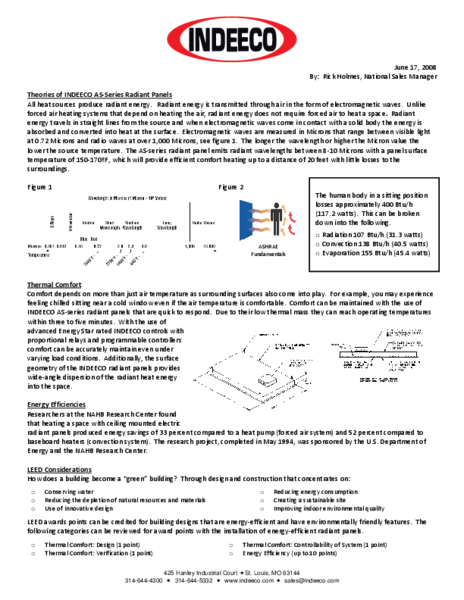
All heat sources produce radiant energy. Radiant energy is transmitted through air in the form of electromagnetic waves. Unlike forced air heating systems that depend on heating the air, radiant energy does not require forced air to heat a space. Radiant energy travels in straight lines from the source and when electromagnetic waves come in contact with a solid body the energy is
absorbed and converted into heat at the surface. Electromagnetic waves are measured in Microns that range between visible light at 0.72 Microns and radio waves at over 1,000 Microns, see figure 1. The longer the wavelength or higher the Micron value the lower the source temperature. The AS‐series radiant panel emits radiant wavelengths between 8‐10 Microns with a panel surface
temperature of 150°F ‐ 170ºF, which will provide efficient comfort heating up to a distance of 20 feet with little losses to the surroundings.

Thermal Comfort
Comfort depends on more than just air temperature as surrounding surfaces also come into play. For example, you may experience feeling chilled sitting near a cold window even if the air temperature is comfortable. Comfort can be maintained with the use of Indeeco AS‐series radiant panels that are quick to respond. Due to their low thermal mass they can reach operating temperatures within three to five minutes. With the use of advanced Energy Star rated Indeeco controls with proportional relays and programmable controllers comfort can be accurately maintain even under varying load conditions. Additionally, the surface geometry of the Indeeco radiant panels provides wide‐angle dispersion of the radiant heat energy into the space.
Energy Efficiencies
Researchers at the NAHB Research Center found that heating a space with ceiling mounted electric radiant panels produced energy savings of 33 percent compared to a heat pump (forced air system) and 52 percent compared to baseboard heaters (convection system). The research project, completed in May 1994, was sponsored by the U.S. Department of Energy and the NAHB Research Center.
LEED Considerations
How does a building become a “green” building? Through design and construction that concentrates on:
- Conserving water
- Reducing energy consumption
- Reducing the depletion of natural resources and materials
- Creating a sustainable site
- Use of innovative design
- Improving indoor environmental quality
LEED awards points can be credited for building designs that are energy‐efficient and have environmentally friendly features. The following categories can be reviewed for award points with the installation of energy‐efficient radiant panels.
- Thermal Comfort: Design (1 point)
- Thermal Comfort: Controllability of System (1 point)
- Thermal Comfort: Verification (1 point)
- Energy Efficiency (up to 10 points)